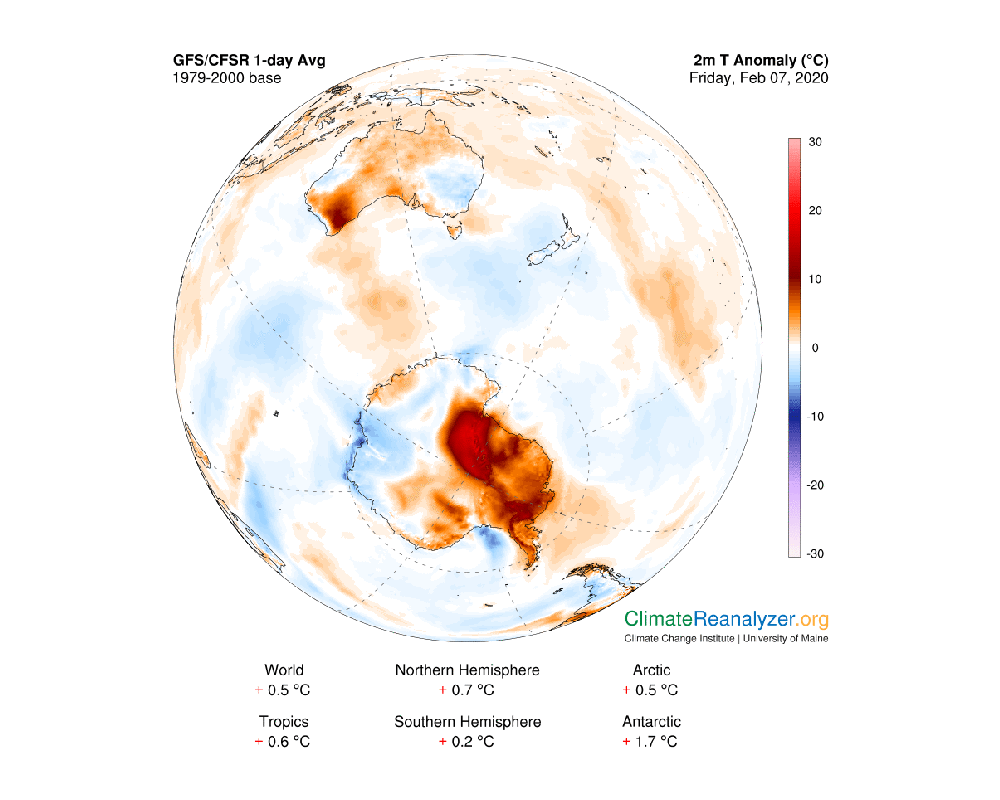Original Article: Washington Post
Just days after the Earth saw its warmest January on record, Antarctica has broken its warmest temperature ever recorded. A reading of 65 degrees was taken Thursday at Esperanza Base along Antarctica’s Trinity Peninsula, making it the ordinarily frigid continent’s highest measured temperature in history.
The Argentine research base is on the northern tip of the Antarctic Peninsula. Randy Cerveny, who tracks extremes for the World Meteorological Organization, called Thursday’s reading a “likely record,” although the mark will still have to be officially reviewed and certified.
The balmy reading beats out the previous record of 63.5 degrees, which occurred March 24, 2015.
The Antarctic Peninsula, on which Thursday’s anomaly was recorded, is one of the fastest-warming regions in the world. In just the past 50 years, temperatures have surged a staggering 5 degrees in response to Earth’s swiftly warming climate. Around 87 percent of glaciers along the peninsula’s west coast have retreated in that time, the majority doing so at an accelerated pace since 2008.
The WMO notes that cracks in the Pine Island Glacier “have been growing rapidly” in the past several days, according to satellite imagery.
The recent spate of warmth owes to a ridge of high pressure that has lingered over the region for several days. High-pressure systems feature sinking air, which favors milder temperatures.
This effect was amplified on a local level because of a “foehn” wind, characterized by air sweeping down a mountain that begins compressing as air pressures rise near the Earth’s surface. That causes additional warming.
Moreover, a look at simulated atmospheric profiles around the time it hit the record indicated warmer air aloft than at the surface — meaning any air that mixed down to ground level could have had an additional leg up in warming.
It’s been an eventful year for climate extremes, and we’re only on Day 38 of 2020. January was the warmest on record globally, according to atmospheric monitoring group Copernicus, with records shattered in Europe and Asia. A number of locales in Eastern Europe and particularly Russia wound up more than 12 to 13 degrees above average.
“[This record] doesn’t come as any surprise,” wrote Eric Steig, a glaciologist studying climate change at the University of Washington. “Although there is decade-to-decade variability, the underlying trend across most of the continent is warming.”
He says this record will probably be broken again in the not-so-distant future.
“That warming has been particularly fast on the Antarctic Peninsula — where Esperanza is — in summer (the season [they’re] now in),” Steig wrote. “So we can expect these sorts of records to be set again and again, even if they aren’t set every single year.”
[Antarctica sets temperature record in 2015]
David Bromwich, a climate researcher at Ohio State University, noted, however, that while the Antarctic Peninsula has warmed strongly since the late 1940s, temperature trends in summer have been variable in recent decades, including a brief cooling spell since 1998. “So overall, this record looks to be a one time extreme event that doesn’t tell us anything about Antarctic climate change,” he wrote in an email.
Additional extreme warmth is likely in the Antarctic Peninsula in the coming days. Temperatures some 40 to 50 degrees above normal are predicted by some models.
Jason Samenow contributed to this report.


